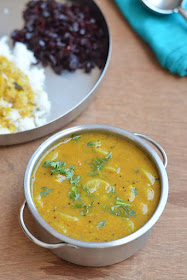I am back after a very long break. Things have become very
busy all of a sudden at the personal front. It feels good to be back to
blogging. I really hope I can be regular with my posting.
Now that I decided to start drafting my post, I am
completely lost for words. So let me get straight to the recipe. Today, I am
sharing a kuzhambu recipe. Unlike most of the other kuzhambu/kootan recipes on
the blog, which I have grown up with, this is a relatively new recipe. My
mother got to know of it from a very good friend of hers. And since then, my
mother has been making it now and then.
So now that amma is here with me, I asked her to prepare
this. It is a spicy, tangy and flavorful kuzhambu.. If you have fresh curry
leaves at hand, it is a breeze to prepare and pairs well with any thoran or roast curries like potato or
seppankizhangu.
What you’ll need
- Fresh Curry Leaves – 1 cup, tightly packed
- Tamarind – a gooseberry sized ball
- Turmeric Powder – ½ tsp
- Jaggery – 1 tsp (optional)
- Salt to taste
To roast and grind
- Gingely oil – 1 tsp
- White Urad Dal – 1 tbsp
- Black Pepper – 1 tsp
- Dried Red Chillies – 4 to 5 (increase or decrease according to taste)
- Asafoetida – a small piece
To temper
- Gingely Oil /Nalla Ennai – 2 tsp
- Mustard Seeds – 1 tsp
- Cumin Seeds – ½ tsp
Method
- Soak the tamarind in a cup of hot water for 10 minutes.
- Squeeze and extract the juice and discard the fibers.
- Add 1.5 cups of water more to this.
- Add turmeric powder, jaggery and salt to taste. Place it on medium heat and bring it to a boil.
- In the meanwhile, heat a small kadai with a tsp of oil add the asafoetida, once it puffs up well add the urad dal and fry it on medium heat. Once it starts changing color, add the black pepper and dry red chillies and fry till the chillies are bright red. Take care not to burn the dal. Transfer to a plate and cool.
- Now, grind the roasted ingredients along with the curry leaves to a fine paste adding a little water.
- Add this ground paste to the tamarind water and let it boil on medium heat for 8 to 10 minutes or till the raw smell of the tamarind and curry leaves disappears and the kuzhambu has thickened and reached a saucy consistency. Don't let it thicken too much as it will thicken a little more on cooling.
- Remove from heat.
- Heat a small frying pan with oil, temper with mustard seeds and cumin. Pour the tempering over the kuzhambu.
Flavorful karuvepilai kuzhambu is ready.
Serve with steamed rice and any thoran or potato or
seppankizhangu fry.
Notes
You may saute few shallots and a couple of cloves of garlic if you like, and then add the tamarind water to it and follow the remaining steps.
































